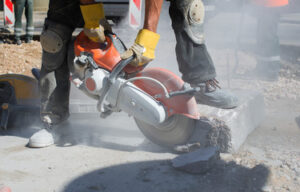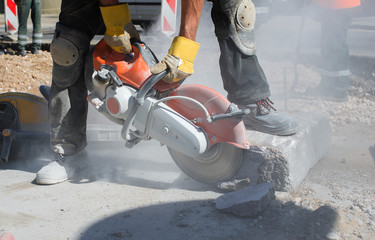Concrete is a common material used in construction. However, it can be damaged by various factors. This can lead to a decrease in strength and an unsightly appearance.
Fortunately, there are solutions for this problem. Concrete Repair Bismarck is a safe and effective method to address damage to concrete surfaces.
Whether you have a leaky basement wall or a cracked sidewalk, hydraulic cement can fix it. This type of cement can be applied wet or dry, and it is highly resistant to heat and chemicals. It can also be used underwater, making it ideal for use in marine environments. If you’re looking for a quick and easy way to repair a crack, this is the best option.
Non-hydraulic cement is more restrictive as it requires constant dry conditions to cure. This makes it unsuitable for outdoor construction, where humidity levels can be unpredictable. In addition, it takes longer to set and gain strength compared with hydraulic cement.
A hydraulic cement can be used to stop leaks and infiltration in concrete structures, as well as fill voids or stabilize soil. It can also be used for permeating concrete for water control or as a liner in pools and ponds.
Hydraulic cement can be found in stores, and it is usually available as a powder that mixes with water to create a paste. It is also available in a variety of formulas to suit different applications. Some blends even expand when they harden, which makes them perfect for sealing leaks and infiltration in concrete and masonry surfaces.
The first step in using hydraulic cement is to prepare the surface by washing it and removing any loose debris. This will help ensure a clean surface that will adhere to the new cement. If there is mold or dirt, these should be removed with muriatic acid to avoid recontamination. You can also lightly roughen the surface to improve adhesion.
After preparing the surface, mix small batches of the hydraulic cement according to the manufacturer’s instructions until you have a thick consistency. Then, apply the cement to the desired surface and work quickly. It sets in about two to three minutes, so you must work quickly and carefully. Be sure to wear gloves and safety glasses when handling the hydraulic cement.
After applying the hydraulic cement, it’s important to mist the area periodically for 24 hours for proper curing. This will prevent the cement from drying out, and it will ensure that the repaired leak is waterproof.
Bonding agents
When repairing concrete, it’s important to use bonding agents to ensure the new concrete sticks properly. This will prevent the repair from failing prematurely, and also help ensure that the repaired surface has a long-lasting and durable finish. Bonding agents are available in a variety of forms, including latex- and epoxy-based. They’re easy to apply with a brush or roller, and should be allowed to dry according to the manufacturer’s instructions.
There are a few different types of concrete bonding chemicals available on the market, each with specific properties designed for a variety of construction circumstances. For example, Roc Prim is a two-part epoxy resin that can be mixed on site and used to bond concrete surfaces together. It’s ideal for industrial floors that experience heavy traffic, as it provides a strong adhesive barrier against moisture. Other popular concrete bonding chemicals include Placeo Cemcol, which is a high-strength epoxy resin that’s ideal for applications that require a hard aggregate surface.
Before applying a bonding agent, it’s important to clean the surface of the existing concrete. This will remove any dirt or debris that can cause damage to the new concrete, and it will also help to improve the adhesion of the bonding agent. A good way to prepare the concrete is to sweep it thoroughly, or even use a pressure washer for large or heavily soiled areas. It’s also important to roughen the concrete surface, as this will create a textured surface that can grip the bonding agent and new concrete.
Concrete is one of the most resilient construction materials, but it can still be damaged by weather conditions, wear and tear, and chemical attacks. When this occurs, it may be necessary to replace the concrete slab altogether. Although replacement is a costly option, it can be the best solution in some cases. If the damage is extensive and compromises the structural integrity of the concrete, it may be more cost-effective to replace the entire slab rather than repairing only the affected area. Regardless of the type of concrete you’re working with, using the proper technique for bonding will result in a long-lasting, durable repair.
Prestressing steel
Prestressing steel is a high-strength material that is used to create reinforced concrete structures. It provides a significant increase in the compression resistance of concrete, and it also improves the tension strength. The technique of prestressing is used in many construction projects, including bridges and buildings. The process involves placing steel bars or strands under tension in the concrete. The concrete then bonds to the steel, providing a stiff and strong structure. In addition, this method of construction reduces construction costs and allows for long-span bridges to be built.
The tendons in prestressed concrete are subjected to significant loads, and they can be damaged by corrosion and other causes. This can impact the load-bearing capacity of the structure, and it is important to repair the tendons as soon as possible. The most suitable repair method depends on the cause of the damage, the location of the damage, and the type of tendons.
To repair a prestressed concrete I-beam, you can remove the end of the beam by cutting or trimming it. However, removing more than 1 inch of the end of a beam is considered to be cutting and will require an NCR from the Fabricator. The NCR will then be reviewed and approved by the TxDOT Inspector.
If you’re planning to repair a prestressed concrete I-beam, it is important to understand the different types of reinforcement and their properties. This will help you to choose the right materials for your project. SkyCiv’s Reinforced Concrete Design Software can help you determine the stress and strains on your member and select the correct reinforcement.
When repairing a prestressed concrete structure, you should consider the condition of the reinforcement and the quality of the concrete. You should use high-strength concrete and a non-shrink additive to achieve the best results. This will ensure that the reinforcement is properly bonded to the concrete and can resist future loading.
It is also important to maintain the shear and flexural capacities of a prestressed bridge. Corrosion of the tendons can lead to reduced shear and flexural capacities, so it’s important to identify and repair the corrosion as quickly as possible. In addition, you should choose a repair method that does not affect the shear and flexural strengths of the bridge.
Epoxy
Epoxy is a resin that can be used to repair cracks in concrete. It is a very strong material that can hold together many different types of materials, such as glass and metal. It is also resistant to heat and chemicals. In fact, it is so good at these things that it is used in a variety of industrial applications. It can even resist corrosion and abrasion.
When used to repair cracks in concrete, epoxy can be injected into the crack. It is also poured over the crack to create a protective layer. This helps to prevent moisture from getting into the cracks and it can be cured in a short period of time. This technique is very effective for repairing cracks in industrial concrete walls.
In addition to repairing concrete wall cracks, epoxy can be used for surface preparation and resurfacing. It is particularly effective for repairing porous and worn concrete surfaces. Moreover, it can be textured to match the texture of surrounding pavements. This process is often performed with a vibratory screed or 3-m (10-ft) straightedge. It is important to remember that a properly prepared surface will produce the best results.
Before using epoxy, be sure to clean the area to be repaired with potable water. Make sure the surface is structurally sound and free of any loose debris. Then, follow the instructions on the package to prepare the surface for application. Once the area is cleaned, it should be dry before use.
The type of epoxy you choose depends on the application. If you need to bond concrete to another material, a polyurethane is a good option. Its curing time is shorter than an epoxies and it produces a flexible bond. It is also resistant to moisture.
If you’re looking for an environmentally friendly product, consider epoxy made with bio-based ingredients. These products have undergone extensive testing for health and environmental effects, so you can rest assured that they’re safe to use.
When selecting an epoxy concrete repair product, look for one with a 1:1 mix ratio. This will ensure that you get the proper consistency for a strong bond. Also, read the TDS (technical data sheet) to determine how long it takes to set. For small repairs, you can use epoxy putty, which is a two-part system that includes an epoxy base and a hardener.
